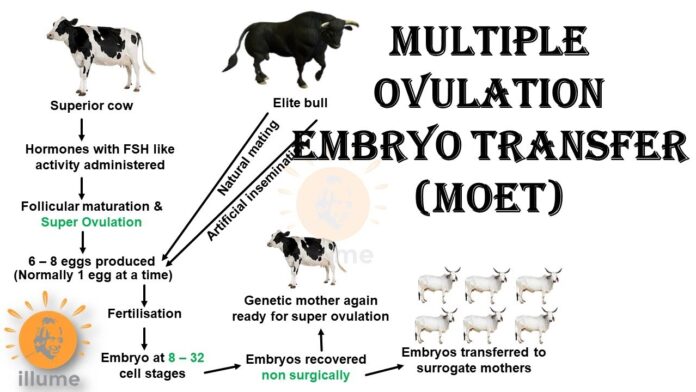Embryo Transfer Technology in Cattle
Embryo transfer is a technique by which embryos are collected from a donor female and are transferred to recipient females, which serve as surrogate mothers for the remainder of pregnancy. Embryo transfer techniques have been applied to nearly every species of domestic animal and to many species of wildlife and exotic animals, including humans and non-human primates. Within the past decade the degree of sophistication of embryo transfer procedures has evolved to permit complete utilization of non-surgical procedures in the cow, long term embryo culture and storage with cryopreservation, and, more recently, micromanipulation and many techniques associated with genetic engineering. This is a rapidly developing science with a very short lag-time between discovery and application. The potential applications continue to increase with the development of new technology.
An embryo is an egg that has already been fertilized by a sperm cell. It is an organism in the earliest stage of development. Embryo transfer is one step in the process of removing one or more embryos from the reproductive tract of a donor female and transferring them to one or more recipient females. Embryo transfer was first performed and recorded by Walter Heape in 1890. He transferred two Angora rabbit embryos into a gestating Belgian doe .The Belgian doe produced a mixed litter of Belgian and Angora bunnies. Embryo transfer in food animals began in the 1930s with sheep and goats, but it was not until the 1950s that successful embryo transfers were reported in cattle and pigs by Jim Rowson at Cambridge, England. By embryo transplanting we are getting new developed high yielding animals.
Embryo transfer is one step in the process of removing one or more embryos from the reproductive tract of a donor female and transferring them to one or more recipient females.
STEP FOR EMBRYO TRANSFER IN CATTLE
1.) Selection of donor cow
2) Super ovulation of donor cow
3) Insemination of cow
4) Flushing of embryo
5) Evaluation of embryo
6) Selection and preparation of recipient female
7) Transfer of embryo
8) Expected embryo transfer result
- Selection of donor cow-:
Embryo transfer in cow
It has been suggested that prospective donor cows in embryo transfer programs be selected on the following criteria:
1) Regular estrous cycles commencing at a young age
2) A history of no more than two breeding per conception
3) Previous calves with approximately 365-day intervals
4) No parturition difficulties or reproductive irregularities
5) No conformational or detectable genetic defects.
2) Super ovulation of the Donor Cow-:
Super ovulation is the release of multiple eggs at a single estrus. Cows or heifers properly treated can release as many as ten or more viable eggs at one estrus. Approximately 85 percent of all normal fertile donors will respond to super ovulation treatment with an average of five transferable embryos. The basic principle of super ovulation is to stimulate extensive follicular development through the use of follicle-stimulating hormone.
SUPER OVULATION OF THE DONOR COW
3. Insemination of the Cow-: Because of the release of many ova from multiple follicles, there is a greater need for viable sperm cells to reach the oviducts of the super ovulated females. Therefore, many embryo transfer technicians will choose to inseminate the cow several times during and after estrus. One scheme is to inseminate the super ovulated cow at 12, 24 and 36 hours after the onset of standing estrus. Using high-quality semen with a high percentage of normal, motile cells is a very critical step in any embryo transfer program. The correct site for semen placement is in the body.
4) Flushing the Embryos-: To collect the embryos non surgically, a small synthetic rubber catheter is inserted through the cervix of the donor cow, and a special medium is flushed into and out of the uterus to collect the embryos seven or eight days after estrus. This collection procedure is relatively simple and can be completed in 30 minutes or less without harm to the cow.
Flushing the Embryos
5) Evaluation of the Embryos-: Regularity of shape of the embryo Compactness of the blastomeric (the dividing cells within the boundaries of the embryo) Variation in cell size Color and texture of the cytoplasm (the fluid within the cell wall) Overall diameter of the embryo Presence of extruded cells Regularity of the zona pellucida.
Classification of embryo: Grade 1: Excellent or good Grade 2: Fair Grade 3: Poor Grade 4: Dead or degenerating .
Evaluation of the embryo under microscope
6) Selection and Preparation of recipient
Females Proper recipient herd management is critical to embryo transfer success. Cows that are reproductively sound, that exhibit calving ease and that have good milking and mothering ability are recipient prospects. They must be on a proper plane of nutrition. Selection and Preparation of recipient Females These cows also must be on a sound herd health program.
7. Transfer of embryo-:
The transfer of the embryo into the recipient cow first requires “loading” the embryo into a 1/4-ml insemination straw. This is done under microscopic viewing with the aid of a 1-ml syringe and requires considerable practice, patience and dexterity. Transfer of embryo
8. Expected Embryo Transplant results-: Embryo production varies greatly from donor to donor and flush to flush. Average production is approximately six freezable (excellent and good) and eight transferable (excellent, good, fair and poor) embryos per super ovulation. Pregnancy rates vary from flush to flush with fresh averages 60 to 70 percent and frozen 50 to 60 percent.
Advantages of embryo transfer in cattle-:
1. The reproductive potential of each normal newborn calf is enormous. There are an estimated 150,000 potential “eggs” or ova in the cow and billions of sperm produced by each bull.
2. By natural breeding, only a fraction of the reproductive potential of an outstanding individual is realized.
3. But, embryo transfer is a technique that can greatly increase the number of offspring that a genetically important cow can produce.
Embryo Transfer Technology in Cattle

EMBRYO TRANSFER TECHNOLOGY IN CATTLE
Cattle Embryo Transfer Technology Procedure_compressed
Compiled & Shared by- This paper is a compilation of groupwork provided by the Team, LITD (Livestock Institute of Training & Development)
Image-Courtesy-Google
Reference-On Request


